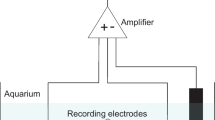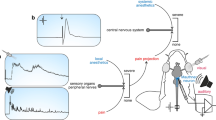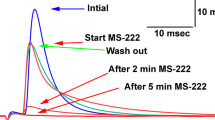Abstract
Urethane and MS-222 are agents widely employed for general anesthesia, yet, besides inducing a state of unconsciousness, little is known about their neurophysiological effects. To investigate these effects, we developed an in vivo assay using the electric organ discharge (EOD) of the weakly electric fish Apteronotus leptorhynchus as a proxy for the neural output of the pacemaker nucleus. The oscillatory neural activity of this brainstem nucleus drives the fish’s EOD in a one-to-one fashion. Anesthesia induced by urethane or MS-222 resulted in pronounced decreases of the EOD frequency, which lasted for up to 3 h. In addition, each of the two agents caused a manifold increase in the generation of transient modulations of the EOD known as chirps. The reduction in EOD frequency can be explained by the modulatory effect of urethane on neurotransmission, and by the blocking of voltage-gated sodium channels by MS-222, both within the circuitry controlling the neural oscillations of the pacemaker nucleus. The present study demonstrates a marked effect of urethane and MS-222 on neural activity within the central nervous system and on the associated animal’s behavior. This calls for caution when conducting neurophysiological experiments under general anesthesia and interpreting their results.














Similar content being viewed by others
Availability of data and materials
Data that support the findings of this study are available from the corresponding author upon reasonable request.
References
Attili S, Hughes SM (2014) Anaesthetic tricaine acts preferentially on neural voltage-gated sodium channels and fails to block directly evoked muscle contraction. PLoS ONE 9:e103751. https://doi.org/10.1371/journal.pone.0103751
Awal MR, Wirak GS, Gabel CV, Connor CW (2020) Collapse of global neuronal states in Caenorhabditis elegans under isoflurane anesthesia. Anesthesiology 133:133–144. https://doi.org/10.1097/ALN.0000000000003304
Bass AH (1986) Electric organs revisited: evolution of a vertebrate communication and orientation organ. In: Bullock TH, Heiligenberg W (eds) Electroreception. John Wiley & Sons, New York, pp 13–70
Bowery NG, Dray A (1978) Reversal of the action of amino acid antagonists by barbiturates and other hypnotic drugs. Br J Pharmacol 63:197–215. https://doi.org/10.1111/j.1476-5381.1978.tb07790.x
Caputi AA (1999) The electric organ discharge of pulse gymnotiforms: the transformation of a simple impulse into a complex spatio-temporal electromotor pattern. J Exp Biol 202:1229–1241. https://doi.org/10.1242/jeb.202.10.1229
Daló NL, Hackman JC (2013) The anesthetic urethane blocks excitatory amino acid responses but not GABA responses in isolated frog spinal cords. J Anesth 27:98–103. https://doi.org/10.1007/s00540-012-1466-7
Dye J (1988) An in vitro physiological preparation of a vertebrate communicatory behavior: chirping in the weakly electric fish, Apteronotus. J Comp Physiol A 163:445–458. https://doi.org/10.1007/BF00604899
Dye J (1991) Ionic and synaptic mechanisms underlying a brainstem oscillator: an in vitro study of the pacemaker nucleus of Apteronotus. J Comp Physiol A 168:521–532
Dye J, Heiligenberg W (1987) Intracellular recording in the medullary pacemaker nucleus of the weakly electric fish, Apteronotus, during modulatory behaviors. J Comp Physiol A 161:187–200
Dye JC, Meyer JH (1986) Central control of the electric organ discharge in weakly electric fish. In: Bullock TH, Heiligenberg W (eds) Electroreception. John Wiley & Sons, New York, pp 71–102
Dye J, Heiligenberg W, Keller CH, Kawasaki M (1989) Different classes of glutamate receptors mediate distinct behaviors in a single brainstem nucleus. Proc Natl Acad Sci U S A 86:8993–8997. https://doi.org/10.1073/pnas.86.22.8993
Elekes K, Szabo T (1985) Synaptology of the medullary command (pacemaker) nucleus of the weakly electric fish (Apteronotus leptorhynchus) with particular reference to comparative aspects. Exp Brain Res 60:509–520
Enger PS, Szabo T (1968) Effect of temperature on the discharge rates of the electric organ of some gymnotids. Comp Biochem Physiol 27:625–627. https://doi.org/10.1016/0010-406x(68)90263-6
Engler G, Zupanc GKH (2001) Differential production of chirping behavior evoked by electrical stimulation of the weakly electric fish, Apteronotus leptorhynchus. J Comp Physiol A 187:747–756. https://doi.org/10.1007/s00359-001-0248-8
Engler G, Fogarty CM, Banks JR, Zupanc GKH (2000) Spontaneous modulations of the electric organ discharge in the weakly electric fish, Apteronotus leptorhynchus: a biophysical and behavioral analysis. J Comp Physiol A 186:645–660. https://doi.org/10.1007/s003590000118
Fang K, Tang Y, Zhang B, Fang G (2022) Neural activities in music frogs reveal call variations and phylogenetic relationships within the genus Nidirana. Commun Biol 5:550. https://doi.org/10.1038/s42003-022-03504-8
Firestone LL, Sauter JF, Braswell LM, Miller KW (1986) Actions of general anesthetics on acetylcholine receptor-rich membranes from Torpedo californica. Anesthesiology 64:694–702. https://doi.org/10.1097/00000542-198606000-00004
Flecknell P (2009) Laboratory animal anaesthesia, 3rd edn. Academic Press, Amsterdam
Frazier DT, Narahashi T (1975) Tricaine (MS-222): effects on ionic conductances of squid axon membranes. Eur J Pharmacol 33:313–317. https://doi.org/10.1016/0014-2999(75)90175-2
Gamal El-Din TM, Lenaeus MJ, Zheng N, Catterall WA (2018) Fenestrations control resting-state block of a voltage-gated sodium channel. Proc Natl Acad Sci U S A 115:13111–13116. https://doi.org/10.1073/pnas.1814928115
Hara K, Harris RA (2002) The anesthetic mechanism of urethane: the effects on neurotransmitter-gated ion channels. Anesth Analg 94:313–318. https://doi.org/10.1097/00000539-200202000-00015
Hartman D, Lehotzky D, Ilieş I, Levi M, Zupanc GKH (2021) Modeling of sustained spontaneous network oscillations of a sexually dimorphic brainstem nucleus: the role of potassium equilibrium potential. J Comput Neurosci 49:419–439. https://doi.org/10.1007/s10827-021-00789-2
Hedrick MS, Winmill RE (2003) Excitatory and inhibitory effects of tricaine (MS-222) on fictive breathing in isolated bullfrog brain stem. Am J Physiol Regul Integr Comp Physiol 284:R405–R412. https://doi.org/10.1152/ajpregu.00418.2002
Heiligenberg W, Metzner W, Wong CJH, Keller CH (1996) Motor control of the jamming avoidance response of Apteronotus leptorhynchus: evolutionary changes of a behavior and its neuronal substrates. J Comp Physiol A 179:653–674. https://doi.org/10.1007/BF00216130
Hille B (1977) Local anesthetics: hydrophilic and hydrophobic pathways for the drug-receptor reaction. J Gen Physiol 69:497–515. https://doi.org/10.1085/jgp.69.4.497
Hudson AE (2020) Anesthesia as decoupling? Anesthesiology 133:11–12. https://doi.org/10.1097/ALN.0000000000003366
Ilieş I, Zupanc GKH (2023) Computational modeling predicts regulation of central pattern generator oscillations by size and density of the underlying heterogenous network. J Comput Neurosci 51:87–105. https://doi.org/10.1007/s10827-022-00835-7
Ilieş I, Traniello IM, Sîrbulescu RF, Zupanc GKH (2014) Determination of relative age using growth increments of scales as a minimally invasive method in the tropical freshwater Apteronotus leptorhynchus. J Fish Biol 84:1312–1325
Kawasaki M, Maler L, Rose GJ, Heiligenberg W (1988) Anatomical and functional organization of the prepacemaker nucleus in gymnotiform electric fish: the accommodation of two behaviors in one nucleus. J Comp Neurol 276:113–131. https://doi.org/10.1002/cne.902760108
Kelz MB, Mashour GA (2019) The biology of general anesthesia from Paramecium to primate. Curr Biol 29:R1199–R1210. https://doi.org/10.1016/j.cub.2019.09.071
Kispersky TJ, Caplan JS, Marder E (2012) Increase in sodium conductance decreases firing rate and gain in model neurons. J Neurosci 32:10995–11004. https://doi.org/10.1523/JNEUROSCI.2045-12.2012
Lea WA, Xi J, Jadhav A, Lu L, Austin CP, Simeonov A, Eckenhoff RG (2009) A high-throughput approach for identification of novel general anesthetics. PLoS ONE 4:e7150. https://doi.org/10.1371/journal.pone.0007150
Leonard J, Matsushita A, Kawasaki M (2022) Morphology and receptive field organization of a temporal processing region in Apteronotus albifrons. J Comp Physiol A 208:405–420. https://doi.org/10.1007/s00359-022-01546-1
Lewis LD, Weiner VS, Mukamel EA, Donoghue JA, Eskandar EN, Madsen JR, Anderson WS, Hochberg LR, Cash SS, Brown EN, Purdon PL (2012) Rapid fragmentation of neuronal networks at the onset of propofol-induced unconsciousness. Proc Natl Acad Sci U S A 109:E3377-3386. https://doi.org/10.1073/pnas.1210907109
Maggi CA, Meli A (1986a) Suitability of urethane anesthesia for physiopharmacological investigations in various systems. Part 1: General considerations. Experientia 42:109–114. https://doi.org/10.1007/BF01952426
Maggi CA, Meli A (1986b) Suitability of urethane anesthesia for physiopharmacological investigations in various systems. Part 2: Cardiovascular system. Experientia 42:292–297. https://doi.org/10.1007/BF01942510
Maggi CA, Meli A (1986c) Suitability of urethane anesthesia for physiopharmacological investigations. Part 3: Other systems and conclusions. Experientia 42:531–537. https://doi.org/10.1007/BF01946692
McKinstry-Wu AR, Bu W, Rai G, Lea WA, Weiser BP, Liang DF, Simeonov A, Jadhav A, Maloney DJ, Eckenhoff RG (2015) Discovery of a novel general anesthetic chemotype using high-throughput screening. Anesthesiology 122:325–333. https://doi.org/10.1097/ALN.0000000000000505
Medler S (2019) Anesthetic MS-222 eliminates nerve and muscle activity in frogs used for physiology teaching laboratories. Adv Physiol Educ 43:69–75. https://doi.org/10.1152/advan.00114.2018
Metzner W (1999) Neural circuitry for communication and jamming avoidance in gymnotiform electric fish. J Exp Biol 202:1365–1375. https://doi.org/10.1242/jeb.202.10.1365
Mondino A, González J, Li D, Mateos D, Osorio L, Cavelli M, Castro-Nin JP, Serantes D, Costa A, Vanini G, Mashour GA, Torterolo P (2022) Urethane anaesthesia exhibits neurophysiological correlates of unconsciousness and is distinct from sleep. Eur J Neurosci. https://doi.org/10.1111/ejn.15690
Moortgat KT, Bullock TH, Sejnowski TJ (2000) Gap junction effects on precision and frequency of a model pacemaker network. J Neurophysiol 83:984–997
Penna M, Araya C, Cañete M (2022) Diversity of temporal response patterns in midbrain auditory neurons of frogs Batrachyla and its relevance for male vocal responses. J Comp Physiol A. https://doi.org/10.1007/s00359-022-01572-z
Perks KE, Sawtell NB (2022) Neural readout of a latency code in the active electrosensory system. Cell Rep 38:110605. https://doi.org/10.1016/j.celrep.2022.110605
Ramlochansingh C, Branoner F, Chagnaud BP, Straka H (2014) Efficacy of tricaine methanesulfonate (MS-222) as an anesthetic agent for blocking sensory-motor responses in Xenopus laevis tadpoles. PLoS ONE 9:e101606. https://doi.org/10.1371/journal.pone.0101606
Schaefer J, Zakon HH (1996) Opposing actions of androgen and estrogen on in vitro firing frequency of neuronal oscillators in the electromotor system. J Neurosci 16:2860–2868. https://doi.org/10.1523/JNEUROSCI.16-08-02860.1996
Schluck G, Wu W, Srivastava A (2021) Intensity estimation for Poisson process with compositional noise. Front Appl Math Stat 7:648984. https://doi.org/10.3389/fams.2021.648984
Shumkova V, Sitdikova V, Rechapov I, Leukhin A, Minlebaev M (2021) Effects of urethane and isoflurane on the sensory evoked response and local blood flow in the early postnatal rat somatosensory cortex. Sci Rep 11:9567. https://doi.org/10.1038/s41598-021-88461-8
Sîrbulescu RF, Ilieş I, Zupanc GKH (2009) Structural and functional regeneration after spinal cord injury in the weakly electric teleost fish, Apteronotus leptorhynchus. J Comp Physiol A 195:699–714
Sîrbulescu RF, Ilieş I, Zupanc GKH (2014) Quantitative analysis reveals dominance of gliogenesis over neurogenesis in an adult brainstem oscillator. Dev Neurobiol 74:934–952. https://doi.org/10.1002/dneu.22176
Stoddard PK, Zakon HH, Markham MR, McAnelly L (2006) Regulation and modulation of electric waveforms in gymnotiform electric fish. J Comp Physiol A 192:613–624. https://doi.org/10.1007/s00359-006-0101-1
Stunkard JA, Miller JC (1974) An outline guide to general anesthesia in exotic species. Vet Med Small Anim Clin 69:1181–1186
Topic Popovic N, Strunjak-Perovic I, Coz-Rakovac R, Barisic J, Jadan M, Persin Berakovic A, Sauerborn Klobucar R (2012) Tricaine methane-sulfonate (MS-222) application in fish anaesthesia. J Appl Ichthyol 28:553–564. https://doi.org/10.1111/j.1439-0426.2012.01950.x
Woll KA, Eckenhoff RG (2018) High-throughput screening to identify anesthetic ligands using Xenopus laevis tadpoles. Methods Enzymol 602:177–187. https://doi.org/10.1016/bs.mie.2018.01.007
Yagishita H, Nishimura Y, Noguchi A, Shikano Y, Ikegaya Y, Sasaki T (2020) Urethane anesthesia suppresses hippocampal subthreshold activity and neuronal synchronization. Brain Res 1749:147137. https://doi.org/10.1016/j.brainres.2020.147137
Zupanc GKH (2002) From oscillators to modulators: behavioral and neural control of modulations of the electric organ discharge in the gymnotiform fish, Apteronotus leptorhynchus. J Physiol Paris 96:459–472. https://doi.org/10.1016/S0928-4257(03)00002-0
Zupanc GKH, Bullock TH (2005) From electrogenesis to electroreception: an overview. In: Bullock TH, Hopkins CD, Popper AN, Fay RR (eds) Electroreception. Springer Science + Business Media, New York, pp 5–46
Zupanc GKH, Heiligenberg W (1992) The structure of the diencephalic prepacemaker nucleus revisited: light microscopic and ultrastructural studies. J Comp Neurol 323:558–569. https://doi.org/10.1002/cne.903230408
Zupanc GKH, Banks JR, Engler G, Beason RC (2003) Temperature dependence of the electric organ discharge in weakly electric fish. In: Ploger BJ, Yasukawa K (eds) Exploring animal behavior in laboratory and field: an hypothesis-testing approach to the development, causation, function, and evolution of animal behavior. Academic Press, Amsterdam, pp 85–94
Zupanc GKH, Sîrbulescu RF, Nichols A, Ilies I (2006) Electric interactions through chirping behavior in the weakly electric fish, Apteronotus leptorhynchus. J Comp Physiol A 192:159–173. https://doi.org/10.1007/s00359-005-0058-5
Zupanc GKH, Ilieş I, Sîrbulescu RF, Zupanc MM (2014) Large-scale identification of proteins involved in the development of a sexually dimorphic behavior. J Neurophysiol 111:1646–1654. https://doi.org/10.1152/jn.00750.2013
Zupanc GKH, Amaro SM, Lehotzky D, Zupanc FB, Leung NY (2019) Glia-mediated modulation of extracellular potassium concentration determines the sexually dimorphic output frequency of a model brainstem oscillator. J Theor Biol 471:117–124. https://doi.org/10.1016/j.jtbi.2019.03.013
Zupanc MM, Engler G, Midson A, Oxberry H, Hurst LA, Symon MR, Zupanc GKH (2001) Light–dark-controlled changes in modulations of the electric organ discharge in the teleost Apteronotus leptorhynchus. Anim Behav 62:1119–1128. https://doi.org/10.1006/anbe.2001.1867
Funding
This study was supported by Grant 1946910 from the National Science Foundation (GKHZ) and a PEAK Experience Summit Award from Northeastern University (AIE).
Author information
Authors and Affiliations
Contributions
GKHZ designed the study; AIE, GKHZ conducted the experiments; AIE, DL, MA, GKHZ analyzed the data; DL designed the algorithms for automatic frequency measurement, chirp detection, and waveform analysis; GKHZ, DL wrote the manuscript; DL, AIE prepared the figures; GKHZ, AIE, DL reviewed and edited the manuscript. All authors read and approved the manuscript.
Corresponding author
Ethics declarations
Conflict of interest
The authors declare no conflict of interest.
Additional information
Handling Editor: Wolfgang Rössler
Publisher's Note
Springer Nature remains neutral with regard to jurisdictional claims in published maps and institutional affiliations.
Supplementary Information
Below is the link to the electronic supplementary material.
Rights and permissions
Springer Nature or its licensor (e.g. a society or other partner) holds exclusive rights to this article under a publishing agreement with the author(s) or other rightsholder(s); author self-archiving of the accepted manuscript version of this article is solely governed by the terms of such publishing agreement and applicable law.
About this article
Cite this article
Eske, A.I., Lehotzky, D., Ahmed, M. et al. The effect of urethane and MS-222 anesthesia on the electric organ discharge of the weakly electric fish Apteronotus leptorhynchus. J Comp Physiol A 209, 437–457 (2023). https://doi.org/10.1007/s00359-022-01606-6
Received:
Revised:
Accepted:
Published:
Issue Date:
DOI: https://doi.org/10.1007/s00359-022-01606-6




